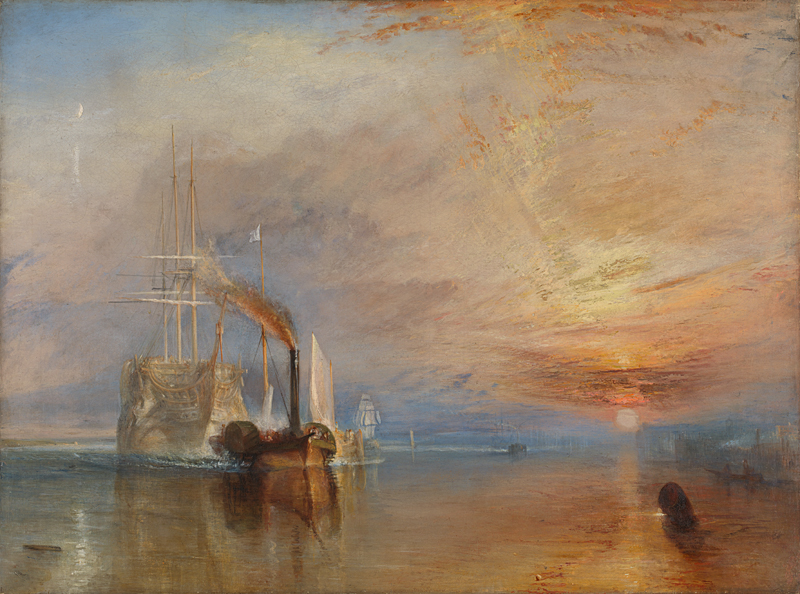This is your last chance to see Turner: Art, Industry & Nostalgia at the Laing Art Gallery, which closes on 7 September 2024. Join over 24,000 people who have seen the exhibition so far.
Turner: Art, Industry & Nostalgia is centred on a work that the British public once voted as their favourite painting – The Fighting Temeraire (1839), on loan from the National Gallery.
As part of National Treasures, a programme marking the National Gallery´s 200th anniversary, The Laing has been lent one of the most recognised and important paintings in the country. Joining this incredible loan are over 20 additional works by Turner, as well as works from artists such as John Constable (1776-1837), James McNeill Whistler (1834-1903), L.S. Lowry (1887-1976), Tacita Dean (b.1965), and photographers John Kippin (b.1950) and Chris Killip (1946-2020).
Turner: Art, Industry & Nostalgia explores the connection between the iconic image of The Fighting Temeraire and the history of Tyneside.
Turner depicted a number of North East views during his lifetime and the exhibition showcases several examples, including Holy Island, Northumberland (about 1829, V&A), a watercolour he made ten years before The Fighting Temeraire, which offers an insight into Turner´s interests such as a seafront setting that includes a remnant of the past, in this case Lindisfarne Castle. Other views of the North East by Turner that are on show include: Newcastle-on-Tyne (1818, Tate), Dunstanburgh Castle (1798, Laing Art Gallery), Warkworth Castle, Northumberland (1799, V&A), Brinkburn Priory, Northumberland (1801, Laing Art Gallery), and Tynemouth, Northumberland (1829, Tate).
Warships and other large vessels appear repeatedly in Turner’s paintings and watercolours. Examples on display include A First Rate Taking in Stores (1818, The Higgins Bedford) and two oil sketches for The Battle of Trafalgar (about 1823, Tate). The battle is also depicted by Turner’s contemporaries, including John Constable and Clarkson Stanfield, which are shown alongside models of the Temeraire from the early 19th-century, as well as a piece of oak from the Temeraire ship itself.
The exhibition also explores connections between the Thames and the Tyne during the industrial revolution. While Turner may not have based the steamboat in The Fighting Temeraire on a specific vessel, it is particularly pertinent to the North East and its industrial heritage that the two steam tugboats that towed the Temeraire in reality – the Samson and the London – were both manufactured on Tyneside. Two smoke-filled canvases, The Thames above Waterloo Bridge (about 1830-5, Tate) and Peace—Burial at Sea (exhibited 1842, Tate) reveal Turner’s interest in the atmospheric effects associated with steam power.
The image of a retired naval vessel on its last journey carries ideas of industry and nostalgia, something that was exploited in 2012´s James Bond film Skyfall, where Bond meets the new Q in front of the painting. This theme extends through to the end of the exhibition with John Kippin’s video piece ARC (2010), which documents the Tyneside-built warship the Ark Royal leaving the River Tyne for the last time. This video piece joins 19 other works that explore the continuing story of the industrial landscape in art.
With the context and connection to the history of Tyneside at the forefront of this special exhibition, this National Treasure is seen in a whole new light at the Laing.
Julie Milne, Chief Curator of Art Galleries for Tyne & Wear Archives & Museums, said:
“Turner: Art, Industry & Nostalgia showcases one of Turner’s greatest masterpieces at the Laing Art Gallery, which provides us with the opportunity to explore the painting’s – and Turner’s – connections to the North East.
We hope that the themes of industry connect with people’s shared histories and lived experience, celebrate our cultural heritage, and reflect on what is important to us individually and collectively.
We are delighted that over 24,000 people have seen the exhibition so far and we look forward to welcoming even more visitors before the exhibition closes on 7 September.”

